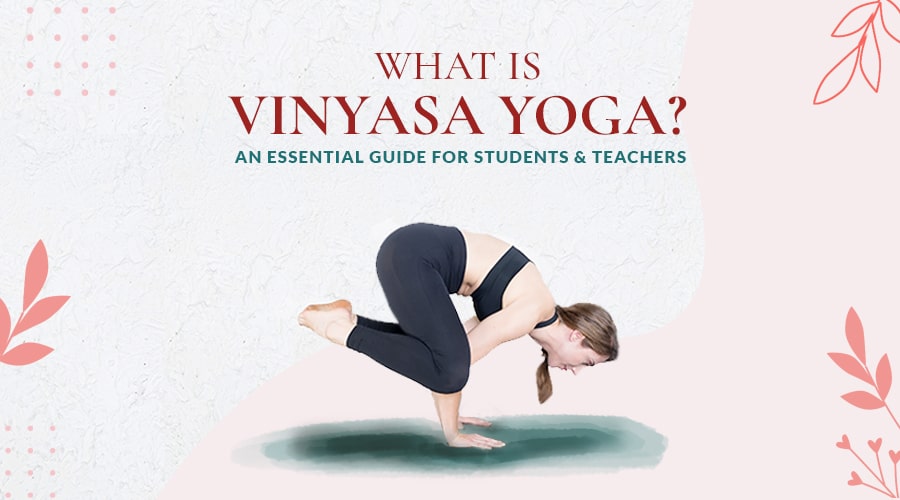Vinyasa Yoga is a widely popular style of yoga distinct for its focus on breath with movement. It is typically described as a practice composed of poses which are linked by breath and associated with a common theme or purpose. But the definition of Vinyasa will differ depending on who you ask.
Unlike rigid practices like Bikram Yoga or Ashtanga Yoga that have fixed sequences, Vinyasa has as many variations as there are teachers. So, what is Vinyasa Yoga and where did it all start? Read on to unravel the origins of Vinyasa Yoga, its actual meaning, and how to practice and teach it properly.
What Is Vinyasa (Flow Yoga)?
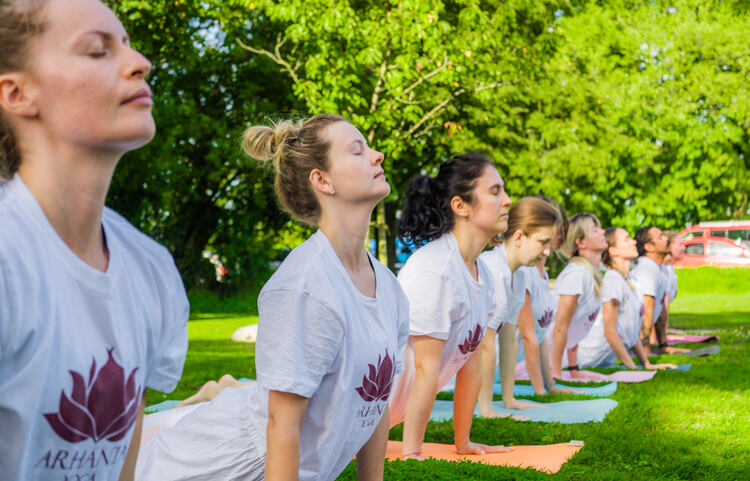
Modern Vinyasa Yoga (also known as Flow Yoga) is best described as freestyle Ashtanga Vinyasa as it doesn’t adhere to the rigid structure of the Ashtanga Vinyasa series set out by K. Pattabhi Jois. It allows for movement from one pose to the next rather than moving through poses statically.
Many Vinyasa Flow classes found at yoga studios today follow the basic structure of the Ashtanga Primary Series, starting with Surya Namaskar A and B and offering different sequences thereafter. Classes also closely follow the basic standing sequence of the Ashtanga tradition as well as the finishing sequence.
There is no fixed series of poses in Vinyasa Yoga. Each class can be different. The basic syntax of Vinyasa Yoga allows you to explore a changing syllabus of poses. You can practice poses from the Ashtanga first, second, and third series in a more accessible manner than in the classic Ashtanga Vinyasa series practice.
Still confused between Ashtanga vs Vinyasa? Read: Ashtanga Yoga, Ashtanga Vinyasa Yoga & Raja Yoga – Understanding the Differences
What Does Vinyasa Mean?
The term Vinyasa is a combination of two words. Nyasa has several meanings like "to place", “special order”, and “attention”. Vi means “specially". Vinyasa has many meanings in the Sanskrit language, however, in the context of yoga, Vinyasa can be best interpreted as:
- special way
- special order
- with attention
Vinyasa, written in lowercase, usually refers to the progression and continuity between the asanas. Ashtanga Vinyasa Yoga is known for its fluid transitions from one pose to another, or jump-backs and jump-throughs. The most common usage is to define a specific linking sequence (based on the sun salutation: chaturanga/up dog/down dog) that is coordinated with the breath and moves you from pose to pose. The practice becomes a flow timed to the breath instead of just a series of postures.
The vinyasa gives rhythm to the practice, increases the heat, builds upper body strength, and acts as a counterpose to stretch the legs and re-set the spine to neutral for the next sequence. Therefore, any sequence flowing from asana to asana can be called a vinyasa—it doesn't have to be related to the sun salutation movements encountered in Ashtanga Vinyasa.
Keeping the concept of moving consciously "in a special way" in mind, a Vinyasa Flow class focuses on relationships between poses, progressing from simpler to more complex asanas. Teachers will also set an intention for the practice and work on strengthening the body-breath-mind connection.
Hatha vs Vinyasa Yoga - What’s the Difference?
What is the difference between Hatha and Vinyasa Yoga? This is a question I hear quite often, and rightly so. As with Ashtanga, Hatha and Vinyasa often get confused as they share similar postures. However, the key difference between Hatha and Vinyasa comes down to the pace and flow of poses.
In classical Hatha Yoga, we focus on holding static asanas for an extended period of time in order to align the body and mind. Vinyasa Yoga on the other hand involves smoothly transitioning between poses in a flowing sequence synchronized with the breath. Both styles incorporate fundamentals like proper alignment, concentration, and controlled breathing with the aim to connect the mind, body, and breath.
Where Did Vinyasa Yoga Originate?
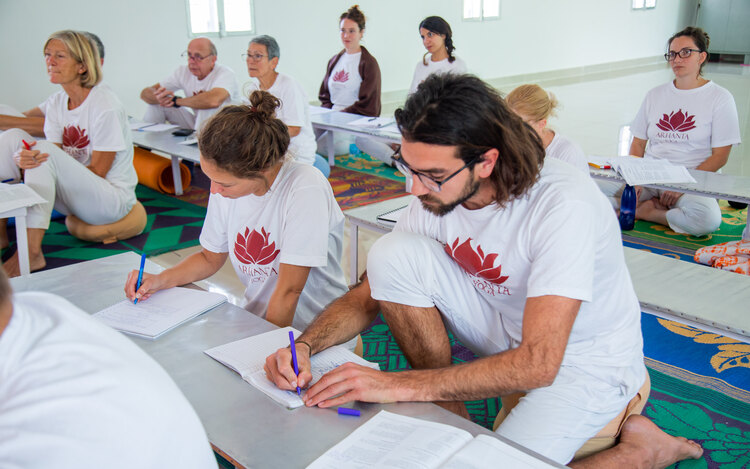
Vinyasa Yoga, or Vinyasa Flow, is not a system and does not follow a clear lineage, hierarchy, or leading guru. Vinyasa Yoga is a modern style of yoga, born out of the Ashtanga Vinyasa Yoga tradition.
The Ashtanga Vinyasa is based on the teachings of Sri Krishnamacharya. Krishnamacharya believed that the movements between each asana were just as significant as the postures themselves. Rather than focusing on “getting into the posture” and then breathing, in Vinyasa Yoga, the aim was to keep the deep breathing and body consciousness consistent throughout all movements during the practice.
Tracing back the origins of Vinyasa, you’ll come across the following key figures who were responsible for bringing Vinyasa to the modern world and helping develop it into the practice we know today.
Sri Tirumalai Krishnamacharya
Krishnamacharya is considered to be the grandfather of modern yoga. He travelled to the Himalayas in 1916 to study yoga. There, he met his guru, Sri Ramamohan Brahmachari, and spent seven-and-a-half years with him. During this time he studied the Ashtanga (Raja) Yoga system, also known as the Eight Limbs of Yoga.
In 1933 he began teaching yoga in Mysore, India, and later in Madras to many Indian and Western students. In addition to Pattabhi Jois, his best-known students include Indra Devi, BKS Iyengar, and his son, TKV Desikachar. Influenced by these masters, various styles of yoga have developed from one source, as their representatives were students of Krishnamacharya at different times. Krishnamacharya taught a diverse practice along with more traditional and original forms of Ashtanga Yoga in Mysore. In Madras, he changed his style, which ultimately became Viniyoga.
T.K.V. Desikachar
T.K.V. Desikachar (1938-2016) was the son of Krishnamacharya. Born in India, T.K.V. Desikachar was disinterested in yoga as a child and early adulthood. After becoming a structural engineer, he returned to his roots and studied under his father. He believed that yoga should be tailored to the individual's needs. He initially used the term, Viniyoga, to describe his style of Hatha Yoga; later he dropped the term, but not the approach.
Desikachar first lectured in the United States in 1976 and later visited regularly, teaching and lecturing on his approach to yoga and yogic healing. He believed that yoga could be relevant for all people, regardless of physical capabilities. Adapting yoga practices to meet the needs of each yogi was central to his approach. Through yoga therapy, he integrated the physical practice of asana, pranayama, meditation, and the traditional medical system of Ayurveda to promote overall well-being and mental health. He was also the founder of Krishnamacharya Yoga Mandiram in Chennai, India.
K.S. Patthabi Jois
The Ashtanga school was developed by Patthabi Jois. He taught in Mysore, India in the first half of the 20th century. Later, Ashtanga Yoga was taught by Jois as moving meditation which he also began to call Ashtanga Vinyasa.
In the practice of Ashtanga Vinyasa Yoga, breath is coordinated with movement. This Ashtanga Vinyasa Yoga is the source of almost all Vinyasa Yoga, Power Yoga, and Yoga Flow styles that have popularized in the West today.
Characteristics of Vinyasa (Flow Yoga)
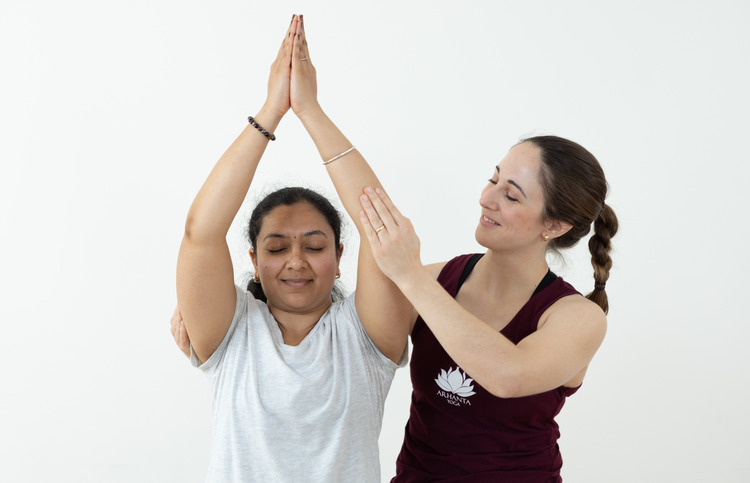
Vinyasa Yoga & Linking of Poses
Vinyasa Yoga links one posture to the next using breath. When the postures are practiced together, they flow into each other. This is why it’s sometimes called “Flow Yoga”. The opposite of Vinyasa Yoga is the more classical style of yoga such as Hatha Yoga, where students come into an asana, steadily stay in the pose and then break the posture by coming out.
Breath & Movement
In Vinyasa, the transition from one asana to the next is always initiated from the breath. The breath might become deeper and more strained due to physical activity, but ideally, it should remain regular and through the nose.
In Vinyasa Flow Yoga, breath creates the rhythm and timing that we rely on to link postures smoothly. Krishnamacharya used to travel from town to town giving yoga performances with his students. To have them move in synchrony, he instructed them to breathe deeper and with a slight construction in the throat. This is commonly known as Ujjayi Breathing, or Ocean Breath.
Dynamic Flow & Pace
A typical Vinyasa Yoga practice involves intense movements that generate a cardiovascular workout not always found in yoga asana practice. For example, in classical Hatha Yoga, we aim to keep the heart rate at a resting pace to stimulate subtle processes in the physical body, lowering stress and improving general health and well-being. In contrast, Vinyasa's fast pace helps boost metabolism, improve heart health, and burn calories, making it a great choice for weight loss and cardiovascular fitness.
Varying Sequences
A defining characteristic of Vinyasa Flow classes is the variation in sequences from class to class. No two classes are alike. If you have done a Vinyasa Yoga class at your yoga studio, you may have noticed this. This stands in stark contrast to fixed form systems like Ashtanga Vinyasa Yoga and Bikram Yoga.
Moving Meditation
Due to its intensity and variety, Vinyasa requires intense focus. The practice can bring you into a state that can be described as moving meditation. Some teachers might also use Ashtanga's 9 Drishti points to enhance focus throughout the practice, while more advanced practitioners will bring their attention inward.
How to Practice Vinyasa Yoga
A Vinyasa Yoga class is very different from a standard Hatha Yoga class. Generally speaking, a Vinyasa Flow class can be more challenging as it focuses on continuous deep breathing and constantly evolving as your practice deepens.
The Sun Salutations from the Ashtanga Vinyasa tradition form the backbone of a Vinyasa Flow Class. Surya Namaskar A and B are used in their "pure" form to warm up the body, and then they are used as a red thread throughout the practice to weave in different asanas and exercises.
If you are a beginner or simply looking for a balanced Vinyasa class to follow at home, try this easy Vinyasa Flow with me for an energy boost in the morning or a full body reset after a tough day at work—your mind and body will thank you.
How to Teach Vinyasa Yoga
Teaching Vinyasa Yoga is relatively easy but it can also be quite challenging. Ultimately, it will depend on how you choose to teach: Do you prefer to mainly stay on your mat and physically demonstrate most of the poses and exercises while explaining the flow? Or, do you like to walk around and verbally guide your students through their practice?
In the first scenario, it is rather easy to teach once you know the flow of the sequence well. However, from this position, you won't be able to see all of your students and adapt your class to their needs and level. I always encourage students in my Vinyasa Yoga Teacher Training Course to teach away from their own mat. By being an active participant in your classes, you can truly assist your students and adjust your sequence to their needs and capabilities.
Below is a simple Vinyasa Yoga sequence you can follow solo at home or try with your students. I've also included effective variations you can weave into your class to make it unique and accessible to all of your students.
Surya Namaskar A
- Start in Samasthiti (Tadasana), with the toes together and heels slightly apart. Keep your arms by your side, spine long.
- Inhale, raise your arms overhead in line with your forehead with palms together and gaze at your thumbs in Angushthamadhyam Drishti.
- Exhale, opening the arms sideways and bend forward with a flat back. Bring the hands to the ground next to your feet, reaching the crown of your head toward the floor.
- Inhale and lift your chest, gazing forward.
- Exhale and step or lightly hop into High Plank. Then, lower down into Chaturanga Dandasana (Four-Limbed Staff Pose).
- Inhale, point your feet, and open your chest. Shoulders should be wide and gaze ahead or diagonally up (Upward-Facing Dog).
- Exhale, curl your toes, and push your hips back and up (you may walk your feet slightly in). Find a steady position in Adho Mukha Svanasana (Downward Facing Dog) and hold for 5 breaths (—1—2—3—4—5—). As you exhale, bend your knees and gaze between your hands.
- Inhale, step forward with your feet in between your hands, and gaze forward with your chest lifted.
- Exhale, fold down with hands next to your feet and the crown of your head reaching toward the floor.
- Inhale and reach your arms wide to the side. Come up with a flat back and bring your hands overhead. Gaze toward the ceiling at your thumbs, neck elongated.
- Exhale and return to Samasthiti.
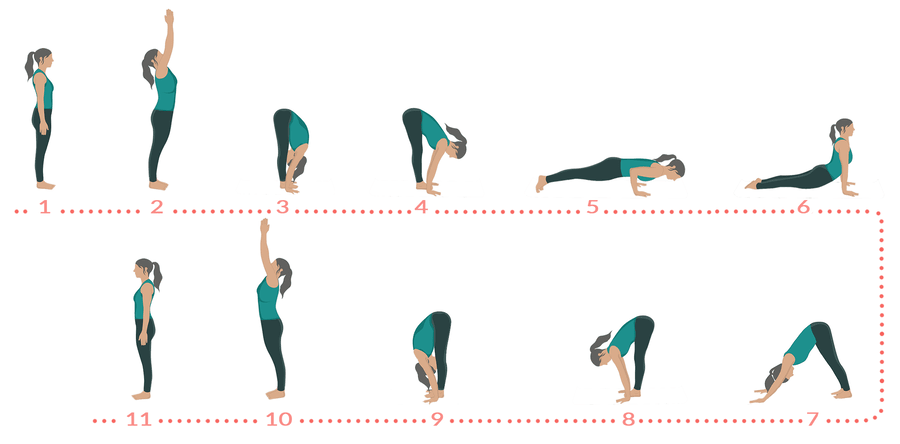
Surya Namaskar B
- Starting in Tadasana (Mountain Pose), stand tall with your toes together and heels slightly apart. Keep your arms by your sides as you elongate your spine.
- Inhale and bend your knees as you raise your arms overhead in prayer position. Gaze at your thumbs as you hold Utkatasana (Chair Pose).
- Exhale and straighten your legs to fold forward, bringing your hands to the mat next to your feet. Reach the crown of your head toward the floor.
- Inhale and lift your chest as you gaze forward.
- Exhale, step or hop back to High Plank, and lower to Chaturanga Dandasana (Four Limbed Staff Pose).
- Inhale, point your feet, and open your chest into Upward Facing Dog.
- Exhale, curl your toes under, and lift your hips into Downward Facing Dog.
- Inhale, step your left foot forward as you sweep your right heel down. Raise your arms overhead in Virabhadrasana I (Warrior I), gazing at your thumbs.
- Exhale, step back to Plank, and lower to Four-Limbed Staff Pose.
- Inhale into Upward Facing Dog.
- Exhale into Downward Facing Dog.
- Inhale, step your right foot forward into Warrior I. Left heel lowers as you lift your arms and gaze up.
- Exhale, step back to Plank and lower down.
- Inhale into Upward Facing Dog.
- Exhale into Downward Facing Dog. Hold for 5 breaths (—1—2—3—4—5—).
- Inhale, hop feet forward. Lift your chest, gazing forward.
- Exhale, fold forward with your head toward the floor.
- Inhale, bend your knees and sweep your arms overhead into Chair Pose.
- Exhale, straighten your legs and lower your arms. Return to Tadasana.
Vinyasa Yoga Poses & Transitions
A vinyasa is a flowing sequence of poses used to transition between asanas. When a teacher says "take a vinyasa," they are asking students to move through the following sequence:
From Plank, lower to Chaturanga Dandasana (Four-Limbed Staff Pose), lift up to Urdhva Mukha Svanasana (Upward Facing Dog), then exhale back to Adho Mukha Svanasana (Downward Facing Dog).
When coming out of a seated pose, the vinyasa involves:
- Lifting up into Upward Facing Dog,
- Then jumping or stepping both feet back to Plank and lowering to Four-Limbed Staff Pose before lifting back to Downward Facing Dog.
This traditional vinyasa sequence comes from Ashtanga Vinyasa Yoga developed by K. Pattabhi Jois. Teachers can also create their own vinyasa flows. For example, in Surya Namaskar B, you could replace Utkatasana (Chair Pose) with:
- Malasana (Garland Pose)
- Parshva Utkatasana (Revolved Chair Pose)
Other replacements could include Chaturanga Dandasana with either:
- Low Plank on elbows,
- Sashtang Pranamasana (Prone Prostration Pose), or
- Supta Eka Pada Rajkapotasana (Sleeping Pigeon Pose).
Urdhva Mukha Shvanasana with:
- Low Cobra / extended Cobra,
- Anahatasana (Melting Heart),
- Shalabhasana (Locust Post), or
- Dhanurasana (Bow Pose).
Virabhadrasana I (Surya Namaskar B) with:
- Virabhadrasana II (Warrior 2) and variations,
- Ashta Chandrasana (Eight Crescent Moon Pose),
- Sukha Hanumanasana (Easy Monkey Pose),
- Utthita Trikonasana (Extended Triangle Pose),
- Utthita Parshvakonasana (Extended Side-Angle Pose), or
- Prasarita Padottanasana (Wide-Legged Standing Forward Bend).
Adho Mukha Shvanasana with:
- Shashankasana (Child's Pose),
- Khagasana (Hare Pose),
- Steady Dolphin, or
- Pincha Mayurasana (Forearm Stand).
Breathing Exercises in Vinyasa Yoga
During the flowing vinyasa section at the start of class, we synchronize our breath with the movements. The teacher counts out 5 breaths for each asana to establish the rhythm. This controlled breathing technique is known as Ujjayi or Ocean Breathing, though it differs from the classical Ujjayi Pranayama.
When practicing Ujjayi breathing in Vinyasa, follow these simple instructions or refer to the guided video below.
- Inhale through your nose and constrict the back of your throat to create a soft wave-like sound, Keep your mouth closed.
- Keep your mouth, jaw, and visible throat area relaxed as you breathe. Imagine you are gently snoring while awake. The ocean sound should be smooth, not forced.
- Only make the sound on the inhale. Let the exhale flow naturally without restriction or force.
By coordinating the breath with the Vinyasa Yoga poses like this, you can find focus, calm, and maintain a controlled heart rate throughout the practice.
Read more: The Difference Between Pranayama and Breathing Exercises
It is our deeply rooted conviction here at Arhanta Yoga, that to grow as a teacher and truly serve your students your full attention should be on the student. Being attentive to your students and observing them will make the difference between them returning to your classes over and over again.
Final Thought
Vinyasa Yoga is a profoundly meaningful practice that connects us to something greater. The flowing sequences are a moving meditation, emphasizing the breath over perfect alignment in poses. As we flow from one asana to the next, guided by the inhales and exhales, we become more present and mindful.
Teaching and practicing vinyasa is rewarding because it develops presence despite life's inevitable ups and downs. The sequences meet us where we are, in each moment, without judgment. It grounds us in this truth and now—we are all part of the greater whole, and there is grace in simply flowing from one breath to the next, together.

